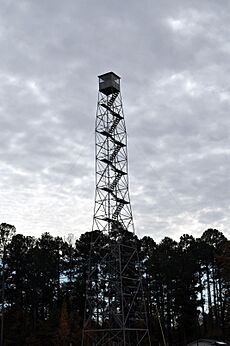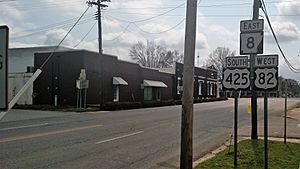Ashley County, Arkansas facts for kids
Quick facts for kids
Ashley County
|
||
|---|---|---|
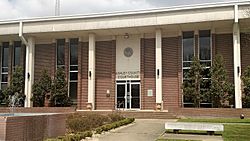
Ashley County Courthouse in Hamburg
|
||
|
||
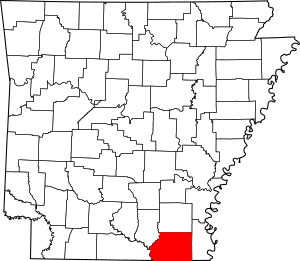
Location within the U.S. state of Arkansas
|
||
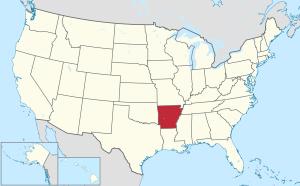 Arkansas's location within the U.S. |
||
| Country | ||
| State | ||
| Founded | November 30, 1848 | |
| Named for | Chester Ashley | |
| Seat | Hamburg | |
| Largest city | Crossett | |
| Area | ||
| • Total | 939.08 sq mi (1,511.3 km2) | |
| • Land | 921.1 sq mi (1,482.5 km2) | |
| • Water | 17.9 sq mi (28.9 km2) | |
| Population
(2020)
|
||
| • Total | 19,062 | |
| • Estimate
(2023)
|
18,262 |
|
| • Density | 20.2986/sq mi (12.6130/km2) | |
| Time zone | UTC−6 (Central) | |
| • Summer (DST) | UTC−5 (CDT) | |
| Congressional district | 4th | |
Ashley County is a rural South Arkansas county with a culture, economy, and history based on timber and agriculture. Created as Arkansas's 52nd county on November 30, 1848, Ashley County has seven incorporated municipalities, including Hamburg, the county seat and Crossett, the most populous city. The county is also the site of numerous unincorporated communities and ghost towns. The county is named for Chester Ashley, a prominent lawyer in the Arkansas Territory and U.S. senator from the state from 1844 to 1848.
The county is roughly divided into two halves by Bayou Bartholomew, with the rich, fertile, alluvial soils of the Arkansas Delta in the east, and the shortleaf pine forests of the Arkansas Timberlands in the west. The county contains six protected areas: Overflow National Wildlife Refuge, Felsenthal National Wildlife Refuge, three Wildlife Management Areas and the Crossett Experimental Forest. Other historical features such as log cabins, one-room school houses, community centers, and museums describe the history and culture of Ashley County.
Ashley County occupies 939.08 square miles (243,220 ha) and contained a population of 19,062 as of the 2020 Census. The economy is largely based on agriculture and small manufacturing. Poverty and unemployment rates are above national averages, but steady. Household incomes are below state and national averages.
Ashley County is mostly served by two school districts, Hamburg School District and Crossett School District. Higher education is provided at University of Arkansas at Monticello College of Technology—Crossett, a public two-year community college in Crossett. Ashley County Medical Center in Crossett is a community hospital providing primary care in the county. Although no Interstate highways serve Ashley County, the county has access to three United States highways (U.S. Route 82 [US 82], US 165, and US 425) and eleven Arkansas state highways. Ashley County is also served by one public owned/public use general aviation airport, Z. M. Jack Stell Field, one electric cooperative (Ashley-Chicot Electric Cooperative), and ten community water systems provide potable water to customers in the county. It is an alcohol prohibition or dry county.
Contents
History
Ashley County, the fifth-largest county in Arkansas in terms of land area, was formed on November 30, 1848 from portions of Drew, Chicot and Union Counties. It was named after Chester Ashley, a US Senator and land speculator. The final borders were laid in 1861. The courtroom in the courthouse has a one-of-a-kind architecture: it is round, and the seats are arranged so that members of the audience can always see each other.
Geography
According to the U.S. Census Bureau, the county has a total area of 941 square miles (2,440 km2), of which 925 square miles (2,400 km2) is land and 15 square miles (39 km2) (1.6%) is water. The lowest point in the state of Arkansas is located on the Ouachita River in Ashley County and Union County, where it flows out of Arkansas and into Louisiana.
Major highways
Adjacent counties
- Drew County (north)
- Chicot County (east)
- Morehouse Parish, Louisiana (south)
- Union Parish, Louisiana (southwest)
- Union County (west)
- Bradley County (northwest)
National protected areas
- Felsenthal National Wildlife Refuge (part)
- Ouachita National Forest (part)
- Overflow National Wildlife Refuge
Demographics
| Historical population | |||
|---|---|---|---|
| Census | Pop. | %± | |
| 1850 | 2,058 | — | |
| 1860 | 8,590 | 317.4% | |
| 1870 | 8,042 | −6.4% | |
| 1880 | 10,156 | 26.3% | |
| 1890 | 13,295 | 30.9% | |
| 1900 | 19,734 | 48.4% | |
| 1910 | 25,268 | 28.0% | |
| 1920 | 23,410 | −7.4% | |
| 1930 | 25,151 | 7.4% | |
| 1940 | 26,785 | 6.5% | |
| 1950 | 25,660 | −4.2% | |
| 1960 | 24,220 | −5.6% | |
| 1970 | 24,976 | 3.1% | |
| 1980 | 26,538 | 6.3% | |
| 1990 | 24,319 | −8.4% | |
| 2000 | 24,209 | −0.5% | |
| 2010 | 21,853 | −9.7% | |
| 2020 | 19,062 | −12.8% | |
| 2023 (est.) | 18,262 | −16.4% | |
| U.S. Decennial Census 1790–1960 1900–1990 1990–2000 2010–2016 |
|||
2020 Census
| Race | Num. | Perc. |
|---|---|---|
| White (non-Hispanic) | 12,685 | 66.55% |
| Black or African American (non-Hispanic) | 4,644 | 24.36% |
| Native American | 25 | 0.13% |
| Asian | 41 | 0.22% |
| Pacific Islander | 6 | 0.03% |
| Other/Mixed | 547 | 2.87% |
| Hispanic or Latino | 1,114 | 5.84% |
As of the 2020 United States census, there were 19,062 people, 7,757 households, and 5,454 families residing in the county.
2010 Census
Racial/Ethnic Makeup of Ashley County treating Hispanics as a Separate Category (2010) White Non-Hispanic (68.2%) Black Non-Hispanic (25.7%) Native American Non-Hispanic (0.2%) Asian Non-Hispanic (0.2%) Pacific Islander Non-Hispanic (0.0%) Other Non-Hispanic (0.0%) Two or more races Non-Hispanic (0.8%) Hispanic Any Race (4.9%)
As of the 2010 census, there were 21,853 people, 8,765 households, and 6,227 families residing in the county. The population density was 23 people per square mile (9/km2). There were 10,137 housing units at an average density of 11 per square mile (4/km2). The racial makeup of the county was 69.3% White, 25.8% Black or African American, 0.3% Native American, 0.5% Asian, 0.2% Pacific Islander, 3.2% from other races, and 1.1% from two or more races. 4.9% of the population were Hispanic or Latino of any race.
There were 8,765 households, out of which 33.9% had children under the age of 18 living with them, 51.5% were married couples living together, 14.9% had a female householder with no husband present, and 29.0% were non-families. 26.1% of all households were made up of individuals, and 11.8% had someone living alone who was 65 years of age or older. The average household size was 2.47 and the average family size was 2.96.
In the county, the population was spread out, with 21.4% under the age of 18, 11.0% from 18 to 24, 23.7% from 25 to 44, 27.6% from 45 to 64, and 16.2% who were 65 years of age or older. The median age was 40.3 years. For every 100 females there were 94.1 males. For every 100 females age 18 and over, there were 90.7 males.
The median income for a household in the county was $23,673, and the median income for a family was $34,934. Males had a median income of $43,594 versus $21,897 for females. The per capita income for the county was $18,779. About 14.3% of families and 18.5% of the population were below the poverty line, including 25.9% of those under age 18 and 12.5% of those age 65 or over.
Human resources
Education
Educational attainment in Ashley County is typical for a rural Arkansas county, with a 2012 study finding 84.9% of Ashley County residents over age 25 held a high school degree or higher and 13.2% holding a bachelor's degree or higher, compared to Arkansas statewide averages of 84.8% and 21.1%. Ashley County is significantly below national averages of 86.7% and 29.8%, respectively.
Primary and secondary education
Two public school districts are based in Ashley County; Hamburg School District is the largest school district in Ashley County, with the Crossett School District serving the west side of the county. Successful completion of the curriculum of these schools leads to graduation from Hamburg High School or Crossett High School, respectively. Both high schools are accredited by the Arkansas Department of Education (ADE). A small area in eastern Ashley County is served by the Lakeside School District, which is based in Lake Village.
Higher education
There are no institutions of higher education in Ashley County. The nearest public community college is Louisiana Delta Community College in Bastrop, Louisiana, followed by South Arkansas Community College in El Dorado. Nearby public four-year universities include University of Arkansas at Monticello, University of Louisiana at Monroe, and Louisiana Tech University in Ruston, Louisiana. The University of Arkansas at Monticello's College of Technology—Crossett, formerly the Forest Echoes Technology Institute, is located between North Crossett and Hamburg and offers associate degrees in general and industrial technology and technical certifications in a number of medical and technical programs.
Libraries
Ashley County has two libraries: the Ashley County Library in Hamburg and Crossett Public Library in Crossett. Both institutions offers books, e-books, media, reference, youth, business and genealogy services.
Culture and contemporary life
Ashley County has several facilities, monuments, and museums dedicated to preserving the history and culture of the area. The Ashley County Museum, owned and operated by the Ashley County Historical Society, preserves and interprets the history and culture of Ashley County for visitors. Four properties related to the history of forestry are listed on the National Register of Historic Places, including the Crossroads Fire Tower, installed by the Civilian Conservation Corps in 1935. The Old Company House Museum in Crossett City Park is one of the original mill houses constructed by the Crossett Lumber Company prior to 1910. The house contains period decorations and offers tours by appointment. Other cultural points of interest in Ashley County include:
- Six churches listed on the NRHP in Ashley County maintain the history and culture of evangelical Protestantism in the area
- The Ashley County Farmer's Market is an informal market (no set times).
- The Hamburg Garden Club has been located in a historic church at the corner of Cherry and Lincoln Streets since 1987.
- Over 75 species are contained at the Crossland Zoo in Crossett.
Annual cultural events
Hamburg hosts the World Famous Armadillo Festival annually during the first weekend in May. The Ashley County Fair is hosted during the first weekend in September at the Ashley County Fairgrounds in Hamburg, and includes a rodeo and the Miss Ashley County pageant in the Maxwell Hill Auditorium. Crossett hosts the Crossett Professional Rodeo Cowboys Association Rodeo in August and the Wiggins Cabin Arts & Crafts Festival each October.
Media
The Ashley County Ledger of Hamburg and the Ashley News Observer of Crossett are the county's two weekly newspapers.
Ashley County is within the Monroe, Louisiana-El Dorado designated market area with the following local TV stations: KNOE (dual ABC/CBS and The CW), KARD (Fox), KTVE (NBC), and two PBS affiliates: KLTM-TV (Louisiana) and KETZ (Arkansas).
The county is home to two FM radio stations: KAGH-FM (104.9 FM, "Today's Country 104.9") and KWLT (102.7 FM). and KAGH (800 AM, "Oldies Radio 800").
Communities
Cities
Town
Census-designated places
Unincorporated community
- Petersburg
- Milo
- Old Milo
- Mist
- Sulphur Springs
- Meridian
- Bovine
- Pugh
- Berlin
- Gulledge
- Snyder
- Thebes
- Sunshine
Townships
Townships in Arkansas are the divisions of a county. Each township includes unincorporated areas; some may have incorporated cities or towns within part of their boundaries. Arkansas townships have limited purposes in modern times. However, the United States Census does list Arkansas population based on townships (sometimes referred to as "county subdivisions" or "minor civil divisions"). Townships are also of value for historical purposes in terms of genealogical research. Each town or city is within one or more townships in an Arkansas county based on census maps and publications. The townships of Ashley County are listed below; listed in parentheses are the cities, towns, and/or census-designated places that are fully or partially inside the township.
- Banner
- Bayou
- Bearhouse
- Beech Creek
- Carter (contains Hamburg)
- De Bastrop (contains Parkdale)
- Egypt (contains Crossett, West Crossett, and most of North Crossett)
- Elon
- Extra
- Longview
- Marais Saline
- Mill Creek (contains part of North Crossett)
- Montrose (contains Montrose)
- Portland (contains Portland)
- Prairie
- Union
- White (contains Fountain Hill)
- Wilmot (contains Wilmot)
Source:
Infrastructure
Aviation
The county contains one public owned/public use airport: Z. M. Jack Stell Field, a small, rural airport east of Crossett with over 16,000 annual operations, almost entirely agricultural spraying operations. Ashley County also contains five private airfields in the eastern part of the county.
Major highways
Ashley County is not served by any Interstate highways; the nearest access to the Interstate system is Interstate 20 (I-20) in Monroe, Louisiana. The county serves as a junction point for several US highways: US Highway 82 (US 82) crosses the county from west to east. This highway runs across South Arkansas, providing access to population centers including El Dorado, Magnolia, and Texarkana. The highway also has two special routes in Ashley County: a spur route to Felsenthal National Wildlife Refuge and business route in Montrose. US 165 and US 425 cross the county from south to north, both run south into Louisiana, with the former running north through the Arkansas Delta to North Little Rock and the latter providing northbound connections to Monticello and Pine Bluff.
Eleven state highway designations serve the traveling public in the county, ranging from short connector routes to long highways traversing the entire county. Highway 8 east-west across the southern part of the state, entering Ashley County from Warren, passing through from northwest to southeast through Hamburg, and exiting Ashley County running east to Eudora. Highway 133 serves north–south traffic around Crossett. Highway 144, two segments of Highway 160, and three segments of Highway 52 provide east–west connectivity. Highway 169 and Highway 189 connect rural areas to Crossett and Hamburg, respectively. Highway 173 connects Overflow NWR to the state highway system. Highway 209 is a minor route in Parkdale.
Utilities
The Ashley-Chicot Electric Cooperative, based in Hamburg, is a non-profit electric utility cooperative serving the rural areas of Ashley County with electric service, as well as parts of adjacent counties. Entergy Arkansas provides electricity for the cities of Hamburg and Crossett and nearby populated outlying areas, and to the small communities along US 165.
The Arkansas Department of Health (ADH) is responsible for the regulation and oversight of public water systems throughout the state. Ten community water systems are based in Ashley County: the Crossett Water Commission, Fountain Hill Waterworks, Hamburg Waterworks, Montrose/Boydell Water System, North Crossett Utilities, Northeast Crossett Water Association, Parkdale Waterworks, Portland Waterworks, Wilmot Waterworks, and the West Ashley County Water Association. All use groundwater as the source. The Crossett Water Commission has the largest direct retail population served (8,038, all in Ashley County), followed by Hamburg (5,481), and North Crossett Utilities (2,924). The remaining water systems have under 1,000 retail population served.
See also
 In Spanish: Condado de Ashley para niños
In Spanish: Condado de Ashley para niños





